|
|
Creator | Title | Description | Subject | Date |
| 1 |
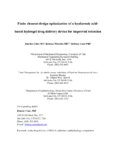 |
Colter, Jourdan; Wirostko, Barbara; Coats, Brittany | Finite element design optimization of hyaluronic acid-based hydrogel drug delivery device for improved retention | Drug-loaded hydrogel devices are emerging as an effective means of localized and sustained drug delivery for the treatment of corneal conditions and injuries. One such device uses a novel, thiolated crosslinked carboxymethylated, hyaluronic acid-based hydrogel (CMHA-S) film to deliver drug to the oc... | Ocular drug delivery; CMHA-S; antibiotics; ophthalmology; computation | 2018 |
| 2 |
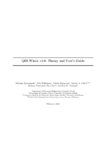 |
Bozorgmehr, Behnam | QES-Winds v1.0: Theory and User's Guide | A new dispersion modeling system based on the well-used FORTRAN-based QUIC (Quick Urban and Industrial Complex) dispersion modeling system originally developed by the University of Utah and Los Alamos National Laboratory [1], has been under development as collaboration between the University of Utah... | | 2021 |
| 3 |
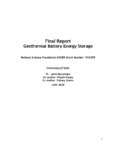 |
McLennan, John | Final Report Geothermal Battery Energy Storage | Solar and wind power are being introduced into electric grids to supplement and replace conventional electricity production. The deployment of utility-scale storage has not kept pace to overcome the intermittent nature of solar and to a lesser extent wind. Large-scale energy storage is cur... | | 2020-06 |
| 4 |
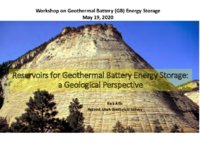 |
Allis, Rick | Reservoirs for Geothermal Battery Energy Report: a geological perspective | Workshop presentation | | 2020-05-18 |
| 5 |
 |
McLennan, John | Large-scale subsurface seasonal heat storage for future value | I too extend my welcome. And, I extend thanks to the NSF for the support of this research at the Univ. of Utah. The concept of storing heat in the ground is certainly not new. Many, many cases have investigated heat to be stored underground. Getting the heat underground is somewhat of a problem, but... | | 2020-05-19 |
| 6 |
 |
McLennan, John | Geothermal Battery Surface Facilities Economics and Finance as an O&G play | | | |
| 7 |
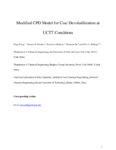 |
Eddings, Eric | Modified CPD Model for Coal Devolatilization at UCTT Conditions | To study coal pyrolysis behavior at underground coal thermal treatment (UCTT) conditions, a modified CPD (M-CPD) model was developed and evaluated using two scales of experiments as well as two different coals, Utah Sufco and Illinois #6. Compared with the original CPD model, three major aspects wer... | Coal; pyrolysis; modeling; underground heating | 2019 |
| 8 |
 |
Eddings, Eric G. | Joint NSF-NSFC Workshop on Combustion Related to Sustainable Energy | A workshop on Combustion Related to Sustainable Energy was held in Hangzhou, China on March 10-12, 2014. The workshop was jointly sponsored by the U.S. National Science Foundation (NSF) and by the National Science Foundation of China (NSFC). The purpose of the workshop was to bring together a limite... | Combustion, sustainable energy, research needs, climate change, renewable fuel, efficiency, Workshop China | 2016 |
| 9 |
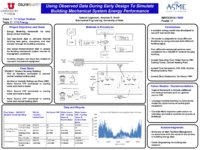 |
Legorburu, Gabriel | Using Observed Data During Early Design To Simulate Building Mechanical System Energy Performance | | Energy Modeling; Real-World Data; Neural Networks | 2019 |
| 10 |
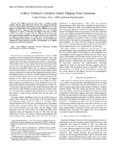 |
Ziegenfuss, Donna | A Busy Professor's Guide to Sanely Flipping Your Classroom | The Flipped Classroom has become a popular teaching method. Students watch video lectures before class, saving class time for active learning (problem solving, demonstrations, applications, etc.). This paper is a useful guide for busy professors who would like to try out the flipped classroom approa... | flipped classroom; inverted classroom; engineering education; teaching electromagnetics; assessment pedagogy | 2019 |
| 11 |
 |
Chrysler, Andrew | Effect of material properties on a subdermal UHF RFID antenna | This paper explores a subdermal RFID antenna at 918 MHz. The antenna, made from ink encapsulated in thin sheets of biocompatible PET, is designed to be implanted in the fat layer just below the skin, with the muscle acting as a lossy ground plane. The antenna is a patch that uses a T-slot for matchi... | Implantable Antennas; Subdermal antennas; Tattoo Antennas; Radio Frequency Identification (RFID); Conductivity | 2018 |
| 12 |
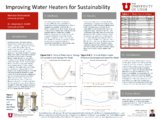 |
Malinowski, Nicholas | Improving water heaters for sustainability | Buildings use about 40% of the total U.S. energy demand. Water heaters provide hot water for a variety of building uses including sinks, showers, dishwashers, washing machines, and space heating. Water heaters are the second most energy intensive appliances in a common household. Typically a home... | Water heaters; Energy efficiency; Electricity; Emissions; Natural gas | 2018 |
| 13 |
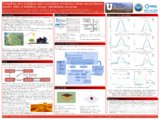 |
Bianchi, Carlo | Coupling of building and vegetation resolving urban microclimate model with a building energy simulation program | The objective of this work is to develop and validate a coupled fast-running Building Energy Modeling/Microclimate model for use in developing site-specific design strategies which minimize energy and water use All the micro-climate variables affecting the building energy consumption, such as solar ... | Building energy modeling; Urban; Microclimate; Simulation; Energy; Environment | 2018-08 |
| 14 |
 |
Legorburu, Gabriel | Energy modeling framework for optimizing heat recovery in a seasonal food processing facility | Societal, cultural and economic factors are driving food processors to reduce energy consumed per unit mass of food. This presents a unique problem because time variant batch processing using low to medium grade heat is common in food production facilities. Heat recovery methods may be implemented b... | Energy efficiency; Food industry; Heat recovery; Optimization; Simulation | 2018-07-20 |
| 15 |
 |
Didier, Richard C. | Linking microclimate and energy use with a low cost wall mounted measurement system | Urban microclimate plays a critical role in overall urban energy demand and efficiency. At the building scale, energy use and internal conditions are directly impacted by local microclimate. The direct link between building energy use and local microclimate is through building envelope heat fluxes. ... | Microclimate; Energy; Temperature; Humidity; Arduino; EnergyPlus | 2016-06 |
| 16 |
 |
Rahman, Aowabin | Deep recurrent neural networks for building energy prediction | This poster illustrates the development of a deep recurrent neural network (RNN) model using long-short-term memory (LSTM) cells to predict energy consumption in buildings at one-hour time resolution over medium-to-long term time horizons ( greater than or equal to 1 week). | Machine learning; Energy; Building energy modeling; Deep learning; Recurrent neural networks; Prediction | 2017-01-13 |
| 17 |
 |
Rahman, Aowabin | Predicting heating demand and sizing a stratified thermal storage tank using deep learning algorithms | This paper evaluates the performance of deep recurrent neural networks in predicting heating demand for a commercial building over a medium-to-long term time horizon (≥ 1 week), and proposes a modeling framework to demonstrate how these longer-term predictions can be used to aid design of a strati... | Building Energy Modeling; Machine Learning; Recurrent Neural Networks; Deep Learning; Heating Load Prediction; Thermal Energy Storage | 2018 |
| 18 |
 |
Smith, Amanda D. | Modeling two-phase flow and vapor cycles using the generalized fluid system simulation program | This work presents three new applications for the general purpose fluid network solver code GFSSP developed at NASA's Marshall Space Flight Center: (1) cooling tower, (2) vapor-compression refrigeration system, and (3) vapor-expansion power generation system. These systems are widely used across eng... | Modeling; Fluid systems; Cooling tower; Vapor compression refrigeration, vapor power cycle | 2017-09 |
| 19 |
 |
Tran, Thomas T.D. | Thermoeconomic analysis of residential rooftop photovoltaic systems with integrated energy storage and resulting impacts on electrical distribution networks | This paper investigates residential rooftop photovoltaic (PV) systems for long-term thermoeconomic benefits from PV homeowners' perspectives and for impacts on the electrical distribution network from grid operators' perspectives. The costs of generating electricity from grid-connected PV systems ar... | Rooftop PV; Net Metering; Distribution Network; Energy storage; LCOE | 2018-07-07 |
| 20 |
 |
Thomas, Tran T. D. | Evaluation of renewable energy technologies and their potential for technical integration and cost-effective use within the U.S. energy sector | Energy demands, environmental impacts of energy conversion, and the depletion of fossil; fuels are constant topics of discussion in the energy industry. Renewable energy technologies; have been proposed for many years to address these concerns. However, the transformation; from traditional methods o... | Renewable energy; Power generation; Electrical grid; Emerging energy systems; System integration | 2017-07 |
| 21 |
 |
Tran, Thomas T. D. | System scaling approach and thermoeconomic analysis of a pressure retarded osmosis system for power production with hypersaline draw solution: A Great Salt Lake study | Osmotic power with pressure retarded osmosis (PRO) is an emerging renewable energy option for locations where fresh water and salt water mix. Energy can be recovered from the salinity gradient between the solutions. This study provides a comprehensive feasibility analysis for a PRO power plant in a ... | Pressure retarded osmosis; Power generation; Renewable energy; Hydroelectric; Levelized cost | 2017-06 |
| 22 |
 |
Rahman, Aowabin | Predicting fuel consumption for commercial building with machine learning algorithms | This paper presents a modeling framework that uses machine learning algorithms to make longterm, i.e. one year-ahead predictions, of fuel consumption in multiple types of commercial prototype buildings at one-hour resolutions. Weather and schedule variables were used as model inputs, and the hourly ... | Building energy modeling; Machine learning; Prediction; Heating load; Data-driven modeling | 2017-08 |
| 23 |
 |
Tran, Thomas T.D. | Incorporating performance-based global sensitivity and uncertainty analysis into LCOE calculations for emerging renewable energy technologies | Assessing system costs for power generation is essential for evaluating the economical aspect of energy resources. This paper examines traditional and renewable energy resources under uncertainty and variability of input variables. The levelized cost of electricity (LCOE) of each technology is compu... | Renewable energy technologies; LCOE levelized cost of electricity | 2018-02-14 |
| 24 |
 |
Rahman, Aowabin | Predicting electricity consumption for commercial and residential buildings using deep recurrent neural networks | This paper presents a recurrent neural network model to make medium-to-long term predictions, i.e. time horizon of ≥ 1 week, of electricity consumption profiles in commercial and residential buildings at one-hour resolution. Residential and commercial buildings are responsible for a significant fr... | Building Energy Modeling; Machine learning; Recurrent neural networks; Deep learning; Electric load prediction | 2017 |
| 25 |
 |
Bianchi, Carlo | Energy demands for commercial buildings with climate variability based on emission scenarios | The impacts of a changing climate are wide-ranging in both impact and scope. This paper investigates the effect that realistic climate variability would have on building energy demands in Salt Lake City, UT to inform planning for air quality impacts. Energy demand scenarios were derived using climat... | BEM; EnergyPlus; Emissions; Climate; Energy | 2017 |

























